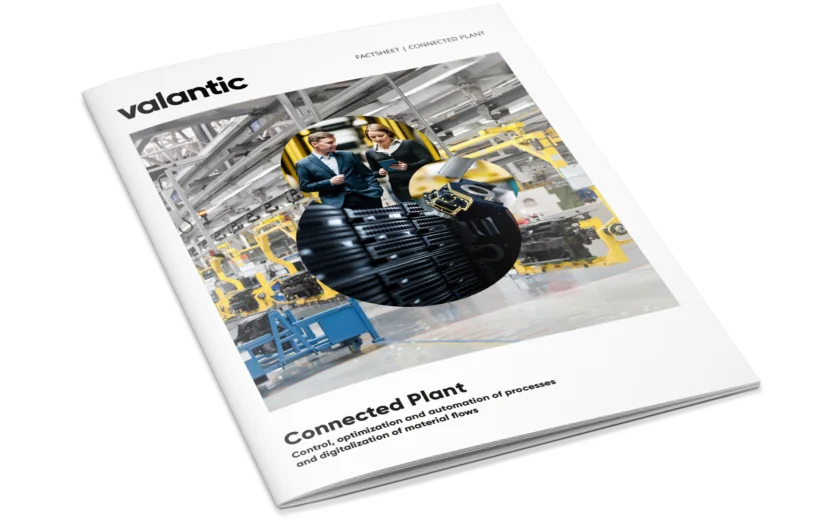Connected Plant
Digitalization of material flows thanks to Connected Plant
Intelligent algorithms, such as machine learning, help monitor, control, optimize, and automate processes realize the digitalization of material flows.

Connected Plant
Intelligent algorithms, such as machine learning, help monitor, control, optimize, and automate processes realize the digitalization of material flows.

Thanks to innovations and trends such as the Internet of Things (IoT), ever larger quantities of data can be generated along the supply chain. However, the mere collection of data doesn’t offer any added value unless that data is analyzed and relevant insights are derived from it. The challenge is to link the collected data intelligently and enrich it in order to gain valuable insights. With a solid database, predictive analyses can contribute to counteracting risks proactively and exploiting optimization potential. Intelligent algorithms, such as machine learning, help monitor, control, optimize, and automate processes and therefore realize the digitalization of material flows.
Thanks to its well-established logistics expertise and deep-reaching process knowledge, valantic helps companies identify the right starting points for a networked plant and ask the right questions for data-driven optimization.
In order to generate added value from data constantly and for the long term, data use cases have to be scaled successfully and tailored to the industry in question. With the combination of our expertise in supply chain management and data science/AI, we create the ideal prerequisites for successful projects with our customers.
valantics Connected Plant

Factsheet Connected Plant
Learn in our factsheet how to identify the right starting points of a networked plant and ask the right questions for data-driven insight generation and implementation of Smart Logistics.
Challenge
A spare parts warehouse in the household appliance industry is struggling with large inventory deviations. During storage, picking, and return processing, human and processing errors occur; these cause inventory deviations.
Solution
Inventory deviations are documented per storage location and item. All up- and downstream stock bookings are maintained in a data warehouse, linked, and assigned to processes. From company-internal inventory booking, transaction, and product characteristic data, process patterns are identified using a segmentation, which in all likelihood cause inventory bookings and thus inventory differences.
Result
Thanks to predictive analytics, processes can be identified that are likely to cause inventory differences. A machine learning algorithm helps with pattern detection in order to prevent inventory deviations and improve inventory quality for the long term.
Challenge
At a manufacturing company, production keeps shutting down due to machine failures and long wait times. This results in high costs. Each machine type has fixed maintenance intervals. Sometimes, the machines fail earlier than expected or maintenance is not yet necessary at the planned point in time. The machines are in several production halls and have different degrees of utilization.
Solution
Information from different data sources is linked and used. On the one hand, data is used to document the history of machine usage. On the other hand, suitable sensors monitor the current state of the machine, in which, e.g. noises and vibrations are analyzed. In addition, environmental information such as temperature and humidity is incorporated. Using the extensive quantity of data, a predictive model can be created, which can predict when a machine requires maintenance and when a component has to be replaced.
Result
Using the data-based forecasts, need-based maintenance can be performed at the right time. Machine shutdowns are reduced and no unnecessary maintenance is performed. In addition, the maintenance times can thus be integrated into the production plan so that machine shutdown times are minimized. This way, maintenance costs and downtimes are reduced significantly and the efficiency of production is increased.
Challenge
The arrival times of important material deliveries fluctuate greatly and deviate from the planned times again and again. Whether deliveries arrive too late is frequently only recognized when they should already be on-site. The unreliability of the arrival times makes planning difficult, causes lower utilization, backlogs, and costs for the purchase of alternatives in time-critical situations.
Solution
Thanks to the linking of past data about deliveries and information about transport, date, time of the planned arrival, relation, etc., it is possible to create a data model with which the arrival time can be predicted. In addition, current weather data, existing GPS locations, and satellite images of ships can be used to make better predictions. This way, it is possible to predict whether an announced date will be adhered to or whether the delivery will arrive too late or too early.
Results
Deviations from planned arrival times can be anticipated, so that more robust planning and efficient processes with shorter throughput and wait times are possible. Deliveries that arrive early can be brought forward in planning in order to achieve a better utilization of loading points. Preventative reactions to possible bottlenecks due to late arrivals are possible and alternative plans can be made early to minimize the negative consequences.
Challenge
The existing logistics processes should be monitored optimally. In case of problems in the supply chain, the responsible employees are notified. Influences and problems here can be quite varied: data and data flows, process delays and errors, logistics resources, and the management of bottlenecks or participating systems (hardware or software). The people in charge of logistics frequently have difficulties detecting current and future problems. There is no overview of all processes and systems.
Solution
A logistics dashboard visualizes and controls the logistics processes in real time. The KPIs and alerts, as well as the required input data and its source systems are defined and brought into harmony thanks to an integrated data architecture. With machine learning algorithms, patterns and risks in the supply chain can be detected preventatively. An organization for the operation and permanent improvement of the dashboard via self-service is implemented.
Result
The logistics dashboard provides employees with an overview of the current state of logistics processes. The state of logistics processes is visualized with user-oriented dashboards. KPIs for performance measurement of material and data flow, as well as defined alerts keep the user up-to-date about the state of the supply chain.
Challenge
Last-minute changes in the sequence of orders in production require a great deal of flexibility from materials management. Logistics should adapt flexibly to production. That’s why tugger trains can no longer drive rigid routes with fixed departure times; instead, they have to adjust flexibly to demands and be as cost-effective as possible.
Solution
Statistical data such as the plant layout and available resources is associated with dynamic data such as information about currently-used means of transport, material calls, and call predictions. In addition, with the use of localization sensors, the precise position of the required materials can be determined. Using this data, it is possible to use an algorithm to determine the optimal route for every state.
Result
At the right time, tugger train drivers see the optimized route with the materials required and the stations to which they have to deliver these on their tablets. The route plan can also be transmitted to driverless transport systems (DTSes) digitally. The optimized routes result in increased efficiency and lower intralogistics costs and at the same time, fulfill the need for flexibility in production.
valantic’s project procedure is always agile and innovative when it comes to implementation. In the Innovation Lab, we work with our customer to focus on the particular use case. Here, we try to describe and define the problem precisely. Data availability and basic conditions are clarified so that the solution space is defined. Our goal is to develop a prototype in the Data Lab as quickly as possible, to test it and make it functional. As part of data operations, the functional prototype then becomes an operative data product.
Approach to Connected Plant Projects